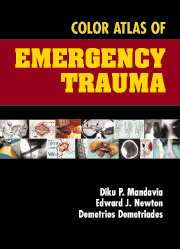6 - MUSCULOSKELETAL INJURY
Published online by Cambridge University Press: 10 November 2010
Summary
Introduction
Orthopedic injuries are found in approximately 85% of blunt trauma victims, and thus expert knowledge in their emergency care is necessary. Many injuries are also acutely life-threatening or limb-threatening and thus need to be evaluated and treated in an expedited fashion. Despite the importance of early treatment, the standard primary survey evaluation with the ABCDE approach is necessary to detect other injuries with a greater priority. During the primary survey, the only attention to musculoskeletal injury is acute hemorrhage control with direct pressure.
Clinical Examination
The physical exam is an integral component of detecting acute orthopedic injuries. The overlying skin should be examined for contusions and lacerations. Lacerations need a more detailed evaluation for neurovascular injury, tendon injury, foreign bodies, and proximity to fracture sites. Cool, pale skin may indicate acute vascular insufficiency. Capillary refill and peripheral pulses should be checked and compared with the unaffected limb. In some cases Doppler ultrasound may be required to detect poor pulses. The compartments should be palpated for firmness that may indicate an acute compartment syndrome. General range of motion and areas of tenderness help guide necessary radiographs. Careful peripheral nerve exam is also important, as nerve injury may be part of the injury complex. Some injuries may not present with any fracture, but ligamentous injury is important to detect.
- Type
- Chapter
- Information
- Color Atlas of Emergency Trauma , pp. 167 - 218Publisher: Cambridge University PressPrint publication year: 2003

